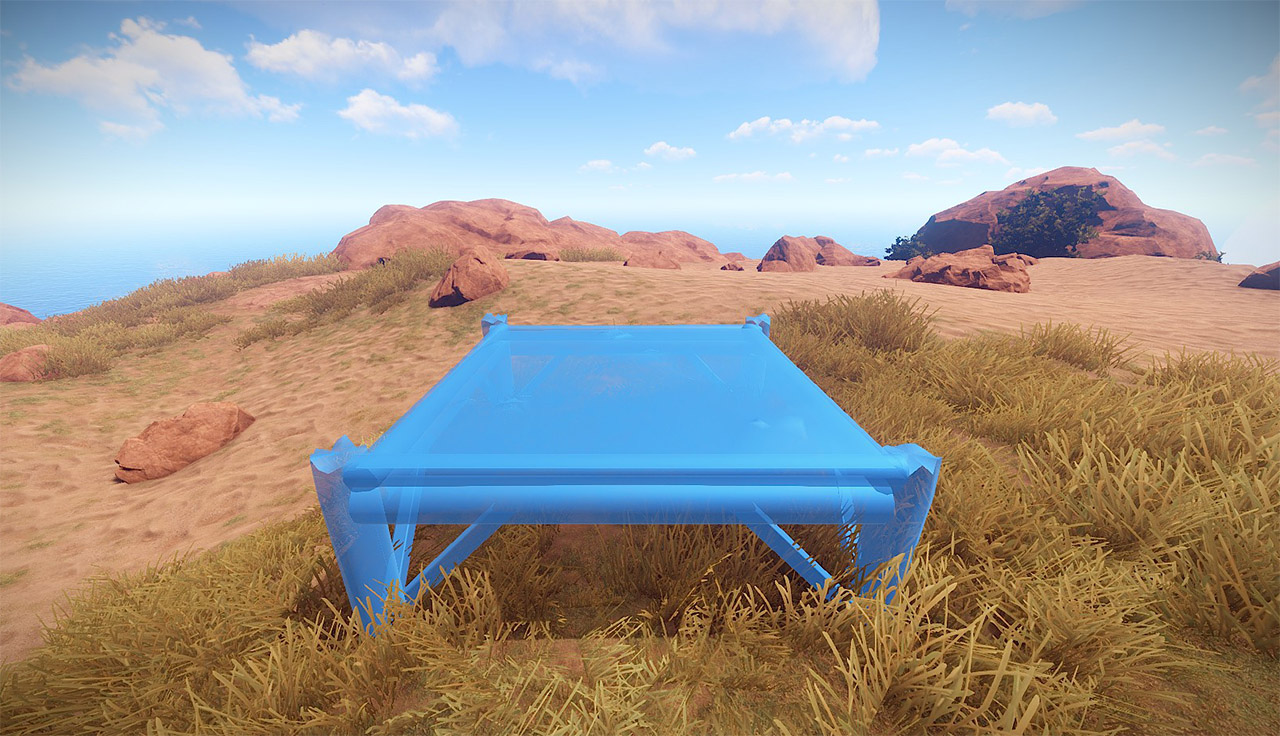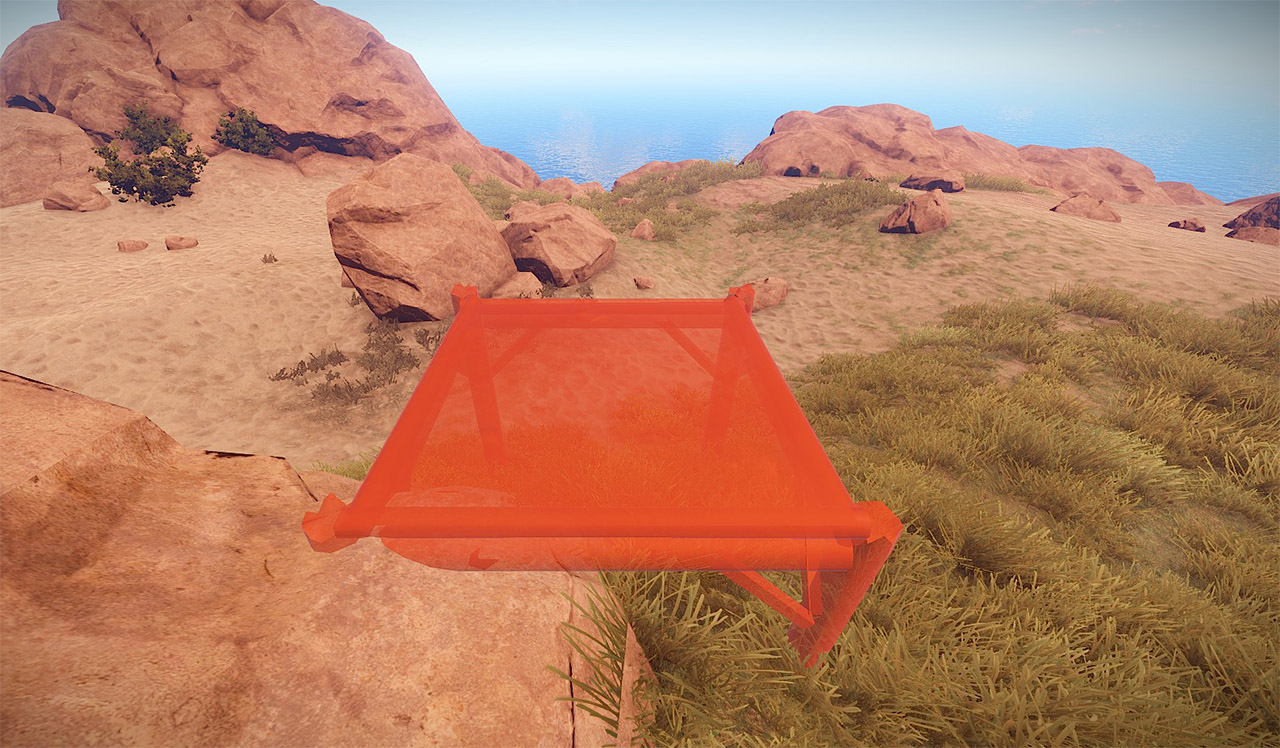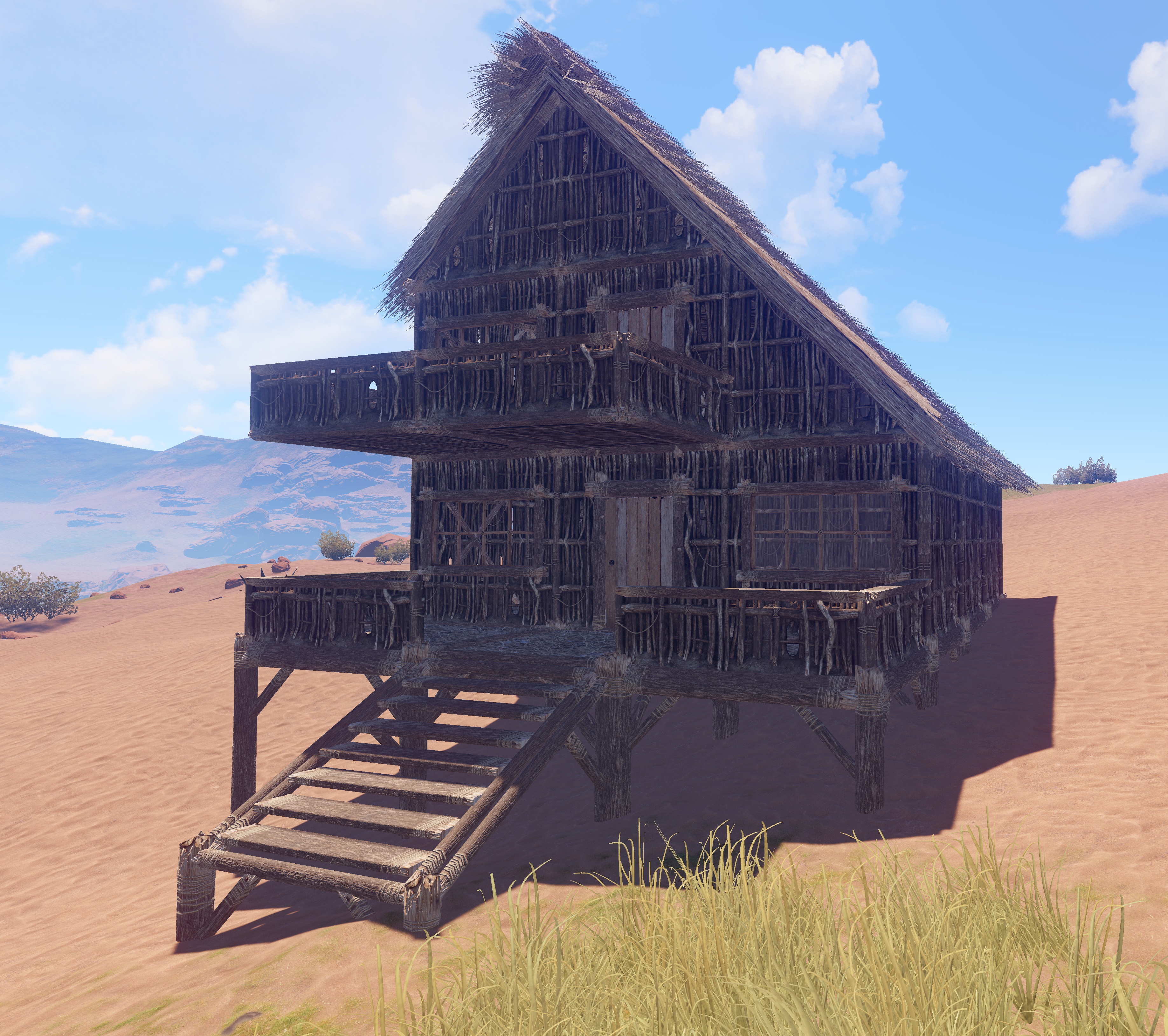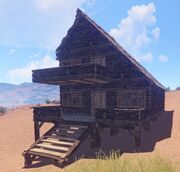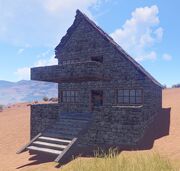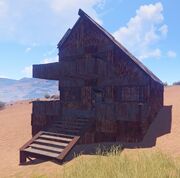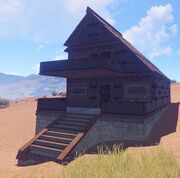Building decaying rust что это
Обновлено: 19.05.2024
Decay is a feature added to the game because of the massive amounts of player-made structures on the map, which the servers can't handle.
Decay works by slowly decreasing the health of the foundations of a structure. If left unattended, the decaying structures will break and, in co-ordination with the stability system, the rest of the building will soon fall apart as well, ultimately leading to the total destruction of a structure. Unlike in earlier builds, decay now affects any and all structures, no matter what the tier or location. Higher tiered structures will generally decay slower, and after a longer delay.
Contents
Other Applications
Other applications available (Not created by Facepunch) that can assist in base designs, and other in-game features.
Tool Cupboard
The Tool Cupboard authorizes players to build within 16 meters of any foundation that is attached to the base which it is placed in. Keep it well guarded (Twig foundations can be built, regardless of the building privileges). To authorize yourself, simply look at it and press E. To remove other players' authorization in that area, hold E and circle to the option to Clear Authorized List.
Building Privilege
If a player has Building Privilege in an area, other players will be prohibited to build in that area. Twigs and ladders can still be placed, but cannot be upgraded. A Tool Cupboard can be set to bestow privilege on a player and their allies.
Contents
Building decaying в Rust. Что делать?
Предположим, вы построили дом из камня, установили в нём железные двери и деревянные решётки на окнах. Если положить в шкаф только камень, забыв о дереве и железе, спустя час – полтора реального времени решётки с дверями сломаются. Случиться это может, кстати говоря, прямо на ваших глазах. Если будете внутри дома или поблизости, услышите характерный треск.
Рекомендую вам закидывать в шкаф ресурсы с запасом. Как только построили соломенный каркас, сразу ставьте на него шкаф и кладите тысячу дерева внутрь. На шкаф, как на дверь, можно прицепить замок. Сделать это стоит, хотя бы, потому что он разбивается ни так легко, как большие деревянные ящики для хранения ресурсов. Если рейдеры до него доберутся, то им проще будет его взорвать или расстрелять разрывными патронами. Соответственно, окупаемость рейда вы установкой замка на ящик хоть как-то понизите.
После улучшения постройки до уровня камня или железа, кладите в ящик запас соответствующего ресурса, которого хватит на месяц. Учтите, если захочется расшириться, лучше проверьте, как это повлияет на потребность в ресурсах. Возможно, вы сократите время жизни постройки с месяца до одного дня, если расширитесь кардинально.
Шкаф лучше прятать за дверями. Если вы играете на сервере без модов или без плагина «Remove», то за стенами его, понятное дело, лучше не прятать. Особенно, если планируется расширение или привлечение других игроков для создания команды. Без авторизации в ящике они ничего не смогут делать в вашем доме, даже поставить костёр будет невозможно.
А на этом все, Дорогие Друзья. Мы надеемся, что гайд "Building decaying в Rust: Что делать?" был полезен для Вас. Ищите больше гайдов по всем играм на нашем сайте!Удачных Вам рейдов, и приятной Вам игры в RUST!
Upgrading Structures
To upgrade a structure, one needs a Hammer. Equip the Hammer, face the structure that you want to upgrade (it will be highlighted), and hold right click. This will give you the available options that the structure can be upgraded to. You will need the necessary materials in your inventory to upgrade any structure.
Like upgrading structures, one needs a Hammer to repair building objects, as well as the necessary resources and tool cupboard access. Simply look at the object (it will be highlighted in green) and left click. The hammer will then swing at the object, and repair damage at the cost of corresponding resources. It may take quite a few swings to repair moderate or severe damage.
Building decaying в Rust: Что делать?

Раньше (пару лет назад) процесс гниения был необратим. Каждый день вы обязательно должны были заходить в игру, чтобы отремонтировать гниющие элементы своей базы. Это была абсолютно необходимая профилактика. Исключения составляли лишь те сервера с модами, где устанавливался плагин «Nodecay». Он существует и по сей день, но уже ни так популярен, потому что разработчики сами решили проблему.
Как вы знаете, в игре есть шкаф с инструментами. Это довольно большая деревянная коробка, похожая на холодильник, установка которой запрещает неавторизованным в ней игрокам строиться в радиусе пятидесяти метров. Раньше шкаф нужен был исключительно для блокировки строительства. То есть, банально для того, чтобы к вашему дому никто не смог подстроиться и начать рейдить с крыши или, что ещё хуже, чтобы рейдер просто не залез в окно на втором этаже.
Сегодня в шкаф можно складывать любую разновидность ресурсов, начиная от угля, заканчивая металлом высокого качества. Зачем это придумано? Чтобы предотвращать гниение! Вы складываете в шкаф те ресурсы, из которых построен ваш дом, и он прекращает разваливаться, а надпись «Building decaying» пропадает из поля зрения.
Если вы загляните внутрь шкафа, там вас сообщится, что именно и в каком количестве необходимо, чтобы предотвратить гниение на одни реальные сутки, то есть, на 24 часа. Чем больше ваше строение, тем оно прожорливее. Содержать огромные замки невыгодно.
No Decay Servers
Some servers (mostly low population) like to opt out of the decay system to make the game more friendly to new players / roleplayers / casuals. These servers usually associate with other friendly tags such as PVE, FRIENDLY COMMUNITY, NO KOS, NO HELI, ANTI - GRIEF.
Guide Video
Here's a guide video that shows you the essentials of Base Building in Rust and a few additional things you might not know.
Building decaying в Rust. Что делать?
Предположим, вы построили дом из камня, установили в нём железные двери и деревянные решётки на окнах. Если положить в шкаф только камень, забыв о дереве и железе, спустя час – полтора реального времени решётки с дверями сломаются. Случиться это может, кстати говоря, прямо на ваших глазах. Если будете внутри дома или поблизости, услышите характерный треск.
Рекомендую вам закидывать в шкаф ресурсы с запасом. Как только построили соломенный каркас, сразу ставьте на него шкаф и кладите тысячу дерева внутрь. На шкаф, как на дверь, можно прицепить замок. Сделать это стоит, хотя бы, потому что он разбивается ни так легко, как большие деревянные ящики для хранения ресурсов. Если рейдеры до него доберутся, то им проще будет его взорвать или расстрелять разрывными патронами. Соответственно, окупаемость рейда вы установкой замка на ящик хоть как-то понизите.
После улучшения постройки до уровня камня или железа, кладите в ящик запас соответствующего ресурса, которого хватит на месяц. Учтите, если захочется расшириться, лучше проверьте, как это повлияет на потребность в ресурсах. Возможно, вы сократите время жизни постройки с месяца до одного дня, если расширитесь кардинально.
Шкаф лучше прятать за дверями. Если вы играете на сервере без модов или без плагина «Remove», то за стенами его, понятное дело, лучше не прятать. Особенно, если планируется расширение или привлечение других игроков для создания команды. Без авторизации в ящике они ничего не смогут делать в вашем доме, даже поставить костёр будет невозможно.
Decay
Linear Decay has been added as of April 16, 2015. Decay is a mechanic in which all building objects will gradually start "decaying". This may not be a visible sign, but it will affect the health of your building. The health of the twig or wood structure will gradually start losing health after a short duration of time (a few hours), and eventually the twig/wood objects will collapse and disappear. Stone, sheet metal, and armored tier foundations will take a bit longer (a few days). To avoid this, try to upgrade objects to stone or higher. In doors with locks that have been opened or closed will reset the decay timer, as long as it is connected and within a certain radius of the door. Decay affects deployables and building structures.
Stability
Stability is a reflection of a structure's endurance; the more stable, the less likely it is to fall apart, if it reaches zero, it will break instantly upon placement. A stability percentage is visible when mousing over a building object at melee range. An easy way to add stability to a structure is to add pillars before placing walls. This should be the second step when building a house, after completing the foundation. Pillars can only be placed if there are no other objects in their path, and if there is a foundation underneath. When building pillars on the second floor or higher, there must be pillars placed below as well.
Decay
Decay is a feature added to the game because of the massive amounts of player-made structures on the map, which the servers can't handle.
Decay works by slowly decreasing the health of the foundations of a structure. If left unattended, the decaying structures will break and, in co-ordination with the stability system, the rest of the building will soon fall apart as well, ultimately leading to the total destruction of a structure. Unlike in earlier builds, decay now affects any and all structures, no matter what the tier or location. Higher tiered structures will generally decay slower, and after a longer delay.
No Decay Servers
Some servers (mostly low population) like to opt out of the decay system to make the game more friendly to new players / roleplayers / casuals. These servers usually associate with other friendly tags such as PVE, FRIENDLY COMMUNITY, NO KOS, NO HELI, ANTI - GRIEF.
Repairing Decay
If a certain part of your base has been partly decayed, then you need to repair it with the resource used to create it. Metal Fragments fix metal structures, Wood fixes wood structures, and so on. To repair, take the Hammer tool, and ensure you have the relevant resources in your inventory. Hit the structure by left clicking, and on each successful hit, the health of the structure will visibly and physically increase until it is repaired fully. If a structure has already collapsed, it is not repairable and must be rebuilt.
Preventing Decay
Decay is prevented by building a cupboard and filling it with materials which are consumed over time.
So if you place a twig wall and run away, after 2 hours it'll start taking damage, and after a further 2 hours it'll be fully destroyed. With armored walls, it means after 24 hours it will begin taking decay damage, and after 5 days it will be destroyed. If at any point a locked door is opened or closed, the delay resets and objects in a 40m radius will have to wait for their decay delay again before taking decay damage. If you haven't played in a few days and your base is half destroyed from decay, you'll still have to repair it but maybe next time have a friend log on and open a door and check the base out so it counts as active and doesn't decay!
Here are some stats:
- Twigs
- 2 Hour Delay
- 2 Hour Duration
- 12 Hour Delay
- 24 Hour Duration
- 18 Hour Delay
- 48 Hour Duration
- 18 Hour Delay
- 72 Hour Duration
- 24 hour Delay
- 120 hour Duration
Repairing Decay
If a certain part of your base has been partly decayed, then you need to repair it with the resource used to create it. Metal Fragments fix metal structures, Wood fixes wood structures, and so on. To repair, take the Hammer tool, and ensure you have the relevant resources in your inventory. Hit the structure by left clicking, and on each successful hit, the health of the structure will visibly and physically increase until it is repaired fully. If a structure has already collapsed, it is not repairable and must be rebuilt.
Building
Stability is a reflection of a structure's endurance; the more stable, the less likely it is to fall apart. If it reaches zero, it will break instantly upon placement. A stability percentage is visible when mousing over a building object at melee range. You can no longer place pillars with walls and are placed in the middle of foundations. This should be the second step when building a house, after completing the foundation. Pillars can only be placed if there are no other objects in their path, and if there is a foundation underneath. When building pillars on the second floor or higher.
Server Settings (Legacy)
There were two server variables that were relevant for controlling the decay speed of structures in Legacy:
This controls the inverval in which all outstanding decay on the server is performed. The faster (shorter) the interval, the more often decay is applied to structures.
Maxhealth controls how much damage will be dealt per second. However, the values for these variables are not straight forward to set. Changing the decay time of structures should be done by changing the deploy_maxhealth_sec setting. Changing decaytickrate is only necessary if there are too many structures on the server that cause lag every time the damage is applied.
To estimate the time a structure needs to decay with given decay settings the following formula can be used:
This can be used to calculate the amount of time needed for an untouched structure to fully decay:
Placing Structures
![]()
Valid building placement
![]()
Invalid building placement
To place a structure, a Building Plan must be crafted. Building plans costs 50 Wood. When the Building Plan is crafted, place it in the hotbar and select it. By default, the foundation object is selected, and you will see a "ghost" of it as you look around. To select other building objects, hold right mouse button, move your mouse in a circle to the object you want, and left click. To begin building, choose either a foundation or a triangular foundation, look at an area suitable for a house, and left click. This will create a Twig Tier foundation. To place walls, select them and aim at the edge of a foundation. Floors must be placed at the top edge of a wall, and doors must be placed inside door frames. Be careful, because as you build up, you have to keep track of the building's stability. If too many floors are built too far away from a wall, it will collapse.
Building Locations
You can build in almost all locations in Rust. All biomes cater for building, and special terrain will also allow for construction. However, steep slopes and uneven ground may prevent building.
Special Terrain Areas may include
Rocks - known for their impenetrability, once a tool cupboard is placed on a rock, it is impossible to get up assuming there are no paths up the rock. *TWIG UPDATE makes building on rocks physically pointless.
Mountains - Most maps have a mountain, usually near the center of the map. This mountain is too steep to place foundations on for the majority of the slope, however with trial and error, it is possible to find a sweet spot and place one foundation. Once the first is down, others will usually snap without a problem.
Rivers, Lakes and Bodies of Water - If the water is shallow enough, it is possible to build on it. Foundations can be placed underwater as well as above water.
Locks
Locks are used to keep people from accessing valuables. Locks can be placed on doors, containers (storage boxes and vending machines) and the Tool Cupboard. There are two different types of locks: the Key Lock which can be crafted with Wood, and the Code Lock which requires Metal Fragments. Both are available to craft by default.
To place a Key Lock, select it and left click on the target. Once deployed, target the lock, hold down the Use key (default "E") and select Lock; only the person who locks the door can open it. To create keys to allow other people through the door, hold down the Use key and select Create Key (requires 25 Wood). Multiple key copies can be created either whoever placed the lock initially or anyone with a key. Other players can kill those who have keys in their inventory and will therefore gain access your base, so keep them safe!
The other lock is the code lock, (100 Metal Fragments) which uses a 4 digit code instead of a key.
Preventing Decay
Decay is prevented by building a Tool Cupboard and filling it with materials which are consumed over time.
Decay Timers
Building
In Rust, players can create their own structures to protect themselves from threats and store their loot.
Building Tiers
There are currently five building tiers in Rust. Some tiers are more vulnerable to raiding than others.
Twig Tier
![]()
Twig Tier house.
Twig Tier components can only be built using a Building Plan. They cannot be downgraded from higher tiers using a Hammer. They cost Wood to build.
Twig Tier components serve as a main foundation for a base's design and can be used to prototype its layout and features.
The costs associated with building a specific component can be viewed in the table to the left.
Twig Tier components have 10 health and are extremely susceptible to all types of damage sources.
The Twig Tier components' purpose is not strictly relegated to just building bases.
They can be used to build temporary defensive structures, often incorporated in base designs, such as destructible drawbridges platforms.
Similarly, they prove to be an essential, offensive element of raiding as they would allow one to construct raid towers and attach platforms to base walls to use as scaffolding, both of which aid in overcoming obstacles and heights.
Twig Tier update
After the Twig Tier Devblog 158 update, defenders are concentrating on two methods: building out from bases with closely packed High External Stone Walls and Metal Barricades, or using the fact that Twig cannot be built above Stairs. The first is expensive; the counter to the latter is to build a twig tower and then place Frames or Doors, then balance a Large Wood Box on top. If the Stairs are not built out far enough, then the player can jump across to the roof. As always, Ladders can be placed on the walls; the counter to this is to build out, and the counter to that is to build Ceilings off of the ladders. In short, the defensive options seem to be, trying to build Stairs further out, and countering ladders with roofs, Signs, Planter Boxes, Barricades etc, or the expensive option of High External Stone Walls with Metal Barricades or possibly Barbed Wooden Barricades.
Wood Tier
![]()
Wood Tier house.
Wood Tier components cannot be built directly, but rather require an existing Twig Tier component to be upgraded using a Hammer. They cost Wood to build.
Higher tiered components cannot be downgraded back to Wood Tier.
The costs associated with upgrading a specific component can be viewed in the table to the left.
Wood Tier components have 250 health and are susceptible to damage inflicted by explosives, projectiles, tools and most significantly - fire.
Wood Tier Doors have 200 health, take 30 seconds to craft and cost 300 Wood.
Upgrading to Wood Tier is mostly only useful in the Early Game, as it is relatively cost-effective and provides a degree of protection.
It is, however, strongly recommended to upgrade Wood Tier structures to a higher Tier as soon as possible.
Wood Tier components are also useful as a temporary component replacement during base expansions, since they can be easily demolished later on.
Stone Tier
![]()
Stone Tier House
Stone Tier components cannot be built directly, but rather require an existing Twig or Wood Tier component to be upgraded using a Hammer. They cost Stones to build.
Higher tiered components cannot be downgraded back to Stone Tier.
The costs associated with upgrading a specific component can be viewed in the table to the left.
Stone Tier components have 500 health and are invulnerable to damage inflicted by fire, most tools and regular projectiles. They are, however, susceptible to high explosive damage, such as Satchel Charges or Rockets. They can also be damaged by Metal Pickaxes and other melee weapons.
Upgrading to Stone Tier remains a viable alternative for the entirety of the game, though, it is particularly useful during Early to Mid Game as the raw materials needed are relatively abundant and do not require any additional processing.
It is strongly recommended to upgrade any Twig or Wood Tier structures to Stone Tier as soon as possible in order to ensure a sufficient degree of base protection.
Sheet Metal Tier
![]()
Sheet Metal Tier house.
Sheet Tier components cannot be built directly, but rather require an existing Twig, Wood, or Stone Tier component to be upgraded using a Hammer. They cost Metal Fragments to build.
Most optimal and readily available option, in terms of cost/performance ratio, that a player can have access to. Sheet Metal Tier components require roughly half the amount of raw materials that Stone Tier does, however, they need to be processed and smelted in a Furnace first.
The only downside to Sheet Metal Tier components is the fact that some of them(e.g., Walls, Foundations) are not fully opaque - the gaps between the attached metal sheets could potentially allow an intruder to view what is behind the wall. A remedy to counteract this would be to upgrade all exterior components of a base to Stone Tier and leave just the interior parts as Sheet Metal.
It is recommended that you always upgrade Floor components as they will remain fully opaque, yet provide all of the strength benefits of the Sheet Metal Tier.
Armored Tier
![]()
Armored Tier house.
Armored Tier is the strongest and final structure upgrade available.
Armored Tier components cannot be built directly, but rather require an existing lower Tier component to be upgraded using a Hammer. They need High Quality Metal to build.
Armored Tier components cannot be downgraded back to lower Tiers.
The costs associated with upgrading a specific component can be viewed in the table to the left.
Armored Tier components have 2000 health and are extremely resistant all sources of damage, with the exception of explosives.
Armored Tier Doors have 800 health, take 30 seconds to craft and cost 5 Gears and 20/25 (single vs double) High Quality Metal.
Even though the Armored Tier provides the highest degree of protection, it is seldom used mainly due to its prohibitive upgrade cost. In comparison to Sheet Metal Tier components and in terms of explosive resistance, Armored Tier components are only 50% stronger, while being orders of magnitude costlier to produce and maintain.
Naturally, one would feel inclined to build a compact loot room and upgrade it to Armored for maximum protection. However, this may prove to be an ill-conceived idea since Armored Tier attracts the attention of raiders. Furthermore, access points such as doorways & wall/floor frames will remain as weak points even when armored since the best available Armored Tier Doors are in many ways equivalent to Sheet Tier.
An uncommonly seen tactic involves building armored, empty, fake loot rooms in hopes of baiting potential raiders into wasting explosives on the decoy room.
Arguably, the most efficient application of the Armored Tier is upgrading Floor tiles. While still quite expensive, the cost to upgrade is halved or even quartered in comparison to regular components, such as Walls and Foundations. Armored Floor tiles will, however, prevent pickaxing and slow down top-down and bottom-up raids the most.
Wall Placement
Server Settings (Legacy)
There were two server variables that were relevant for controlling the decay speed of structures in Legacy:
This controls the interval in which all outstanding decay on the server is performed. The faster (shorter) the interval, the more often decay is applied to structures.
Maxhealth controls how much damage will be dealt per second. However, the values for these variables are not straight forward to set. Changing the decay time of structures should be done by changing the deploy_maxhealth_sec setting. Changing decaytickrate is only necessary if there are too many structures on the server that cause lag every time the damage is applied.
To estimate the time a structure needs to decay with given decay settings the following formula can be used:
This can be used to calculate the amount of time needed for an untouched structure to fully decay:
![Building decaying Rust что делать]()
Раньше (пару лет назад) процесс гниения был необратим. Каждый день вы обязательно должны были заходить в игру, чтобы отремонтировать гниющие элементы своей базы. Это была абсолютно необходимая профилактика. Исключения составляли лишь те сервера с модами, где устанавливался плагин «Nodecay». Он существует и по сей день, но уже ни так популярен, потому что разработчики сами решили проблему.
Как вы знаете, в игре есть шкаф с инструментами. Это довольно большая деревянная коробка, похожая на холодильник, установка которой запрещает неавторизованным в ней игрокам строиться в радиусе пятидесяти метров. Раньше шкаф нужен был исключительно для блокировки строительства. То есть, банально для того, чтобы к вашему дому никто не смог подстроиться и начать рейдить с крыши или, что ещё хуже, чтобы рейдер просто не залез в окно на втором этаже.
Сегодня в шкаф можно складывать любую разновидность ресурсов, начиная от угля, заканчивая металлом высокого качества. Зачем это придумано? Чтобы предотвращать гниение! Вы складываете в шкаф те ресурсы, из которых построен ваш дом, и он прекращает разваливаться, а надпись «Building decaying» пропадает из поля зрения.
Если вы загляните внутрь шкафа, там вас сообщится, что именно и в каком количестве необходимо, чтобы предотвратить гниение на одни реальные сутки, то есть, на 24 часа. Чем больше ваше строение, тем оно прожорливее. Содержать огромные замки невыгодно.
Читайте также:


